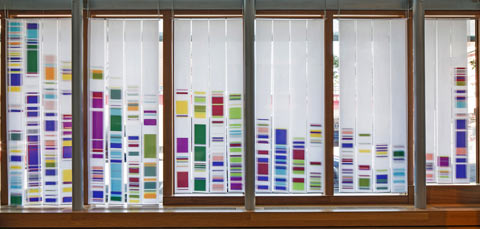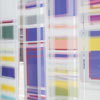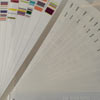Chromosome Painting Edition II
Chromosome Paintings Edition II
Dye sublimation printed sheer silk, Fabricated for the Fi2 Gallery.
108” x 32’
Assistance in sewing from Amy Stewart and Tiphanie Laney.
Original image: Chromosome Painting, Figure 5
Jarllon, Aury, Petit, Thorman. Copyright Clearance,Nature Publishing. 2011
Curator's Statement
For 20 years, Geraldine Ondrizek has created architectural installations based on cellular and genetic images to explore personal, political, and ethical issues related to genetics, ethnicity and human disease. Her work employs textiles, sound and projection on an architectural scale so the viewer can experience the phenomena of material and information in space. Science informs her work: each piece results from lengthy collaborations with scientists and medical researchers with the goal of producing work that visualizes and incorporates scientific data, and comments on contemporary medicine and genetics.
Beginning in 2009 she partnered with the department of medical genetics at the University of Washington to create a body of work that would both commemorate 50 years of medical genetics and honor its founder, Dr. Arno Motulsky. The relationships she formed with the researchers in the department of medical genetics allowed her to further explore the graphic representation of genetic information, resulting in additional art works.
To create Chromosome Paintings, she worked with Dr. Robin Bennett, head of genetic counseling at the University of Washington department of medical genetics, to make a work about genetic testing. Chromosome Paintings is based on a syntiny map, a colorful, striped array that compares gene sequences between species to elucidate the evolution of chromosomes. The technique of chromosome painting, also known as “fluorescence in situ hybridization” can detect chromosomal markers and abnormalities like translocations and structural alterations that are associated with various physical qualities and anomalies. For example, chromosome 2 carries a gene for eye color; chromosome 19 carries a gene implicated in leukemia. Each chromosome contains numerous markers contributing to who we are.
The long silk panels, each printed with human chromosome maps are an arresting displays of fluorescent color arranged to depict chromosomal comparisons. Fuchsia neighbors chartreuse, purple sidles up to orange, soft grays mingle with blues. These juxtapositions spur the eye to dart between various color combinations and arrangements. The origins of the word ‘chromosome’ comes from Greek khroma ‘color’ + soma ‘body.’ These panels, literally made up of different color combinations, physically manifest the ‘color bodies’ (or chromosomes). Chromosome paintings as representations of scientific data are optically stunning and will generate dialogues about vibrancy, complements, contrasts and tonal ranges of the color combinations, which parallel genetic variance, anomalies and similarities.
This new edition of Chromosome Paintings was fabricated for the ZGF window in the summer of 2015 with the help of Amy Stewart and Tiphanie Laney.















